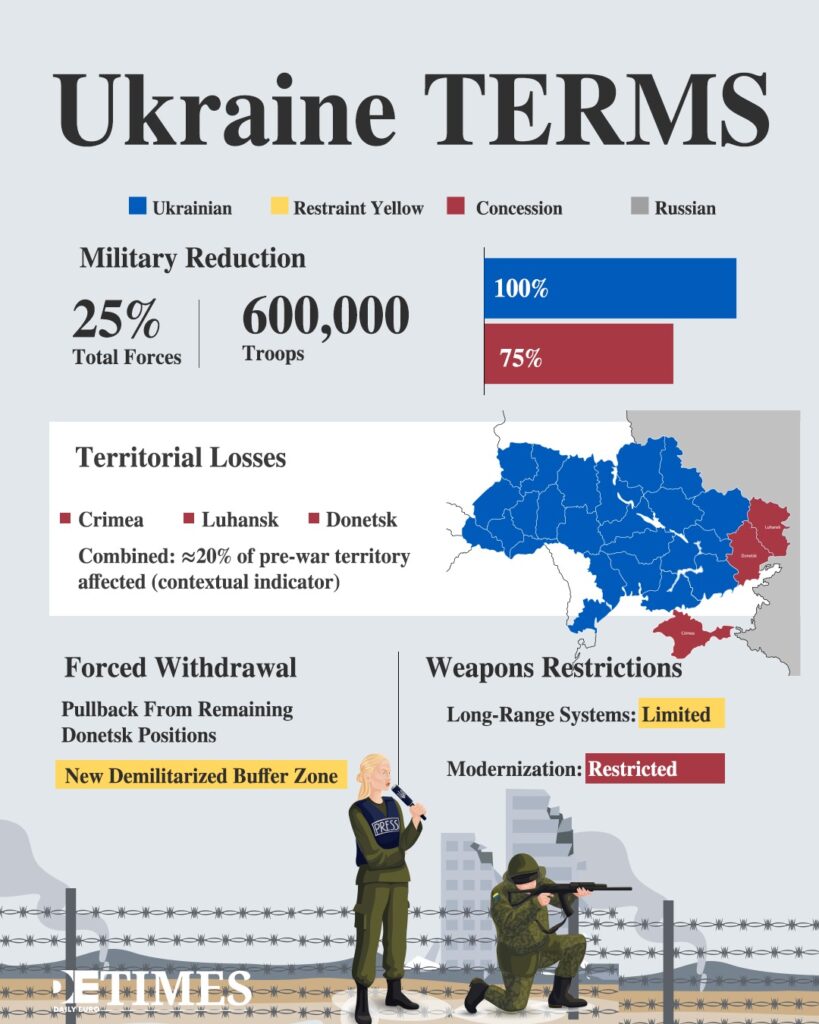On the day a Russian air raid killed twenty-six Ukrainian civilians as they slept, the United States announced its plan to end the war. The announcement, following the raid, was a brutal message.
Hours after the attack on Ternopil, US Army Secretary Daniel Driscoll presented Ukrainian President Volodymyr Zelenskyy with a twenty-eight-point framework for peace. European leaders, left out of the conversation, learned of the deal through media leaks.
The proposal was the product of private talks between American special envoy Steve Witkoff and Kirill Dmitriev, a senior Kremlin aide. Secretary of State Marco Rubio and the President’s son-in-law, Jared Kushner, also contributed. Ukraine and its European partners were not involved.
The Crushing Terms for Kyiv
The American plan demands that Ukraine make devastating concessions.
It would require Kyiv to abandon its pursuit of NATO membership, slash its military by a quarter, and formally cede Crimea, Luhansk, and Donetsk to Russia. The action would reverse decades of American foreign policy.
Under the deal, Ukrainian forces would have to pull back from the parts of Donetsk they still defend. The area would become a demilitarized buffer zone recognized internationally as Russian territory. Ukraine’s military would be capped at six hundred thousand troops, with limits on certain weapons.
In a somber video address, President Zelenskyy described the situation as one of the most trying periods in his country’s history. He characterized Ukraine’s position as a grim calculation before a harsh winter sets in.
Zelenskyy vowed to work with Washington, stating he would not give the enemy a reason to say Ukraine doesn’t want peace. But behind the scenes, pressure is mounting. US officials have warned that should Kyiv not sign by Thanksgiving, intelligence and weapons deliveries could be scaled back.
A Unified Outcry from European Capitals
Across Europe, leaders reacted with defiance.
The European Union’s chief diplomat, Kaja Kallas, was blunt. “The pressure must be on the aggressor, not on the victim,” she told reporters. “Rewarding such actions will only invite more of them.”
French Foreign Minister Jean-Noël Barrot shared a similar view, declaring that peace does “not mean capitulation.” His Polish counterpart, Radosław Sikorski, insisted that since Europe’s own security is “at stake,” it expects to be consulted.
German Chancellor Friedrich Merz stated the obvious: “Wars cannot be ended by major powers over the heads of the countries affected.”
At the G20 summit, a group of ten countries including Germany, France, and the UK issued a joint statement. They acknowledged the plan had some elements for peace but “will require additional work.”
Their biggest worry is the proposed cap on Ukraine’s army, which they warned would leave the country defenceless against future attacks.

Dissent and Cautious Approval
The American initiative found a powerful advocate in Hungarian Prime Minister Viktor Orbán, who praised it as proof that President Trump is “a true rebel.” Orbán then rejected a proposal to send an additional one hundred thirty-five billion euros in EU aid to Kyiv, fracturing European unity.
Moscow has given its tentative blessing. Russian President Vladimir Putin confirmed he had received the text and said it "could form the basis for a final peace settlement."
He also issued a threat, warning that should Kyiv refuse the deal, its territorial losses would proceed.
The Financial Sting in the Fine Print
Tucked away in the plan is a provision with huge financial implications for Europe. It would redirect one hundred billion dollars in frozen Russian assets to a new, US-led reconstruction fund, which would also receive half of all profits.
The arrangement dismantles Europe’s financial leverage, as the EU had intended to use the same assets for Ukraine. In effect, the American plan would grant Moscow commercial benefits from a war of its own making, leaving Europe to absorb the security fallout.
A Reckoning for Brussels
In response to the crisis, European Council President António Costa has called for an emergency meeting of all twenty-seven EU leaders.
The gathering will be a test of whether Brussels can formulate a coherent position on decisions that have, until now, been made elsewhere.
Europe’s choice is to forge a course of action, a response to an arrangement drafted without its input and unfavorable to its long-term interests. While every option is uncomfortable, passivity carries the highest price.
Keep up with Daily Euro Times for more updates!
Read also:
Lifelines as Targets: Moscow’s Playbook for Strangling Ukraine
Europe and Ukraine: Today’s Compromise Becomes Tomorrow’s Defeat
Georgia’s 26% Reality: Occupied Land and Economics






